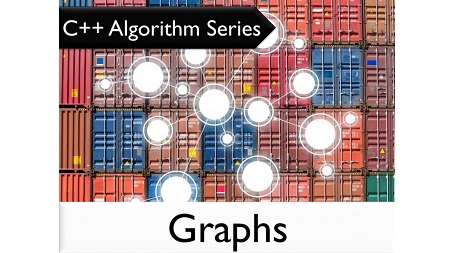
English | MP4 | AVC 1280×720 | AAC 44KHz 2ch | 2h 51m | 469 MB
Know the basics of C++ and want to further sharpen your skills? Then follow along with C++ expert Advait Jayant in his next course in the C++ Algorithm Series, and master how to work with graphs.
The following 13 topics will be covered through a combination of lecture and hands-on to maximize your learning of graphs in C++:
- Introducing Graphs. This first topic in this Graphs course explains the concept of graphs. A graph is a data structure which is represented as a finite set of nodes and edges. The nodes in a graph are called “vertices” and edges connect any two vertices. Explore graph use cases. Know the important graph concepts of adjacent, degree, in-degree, out-degree, path, connected graph, subgraph, connected component, tree, forest, and minimum spanning tree.
- How a Computer Sees a Graph. This second topic in this Graphs course explains how to represent undirected and directed graphs in memory. All of the graph concepts from the first video are shown how they will look through the eyes of a computer. Practice the Edge List, Adjacency Matrix, and Adjacency List Approaches.
- Implementing the Adjacency List Approach for Integers in C++. This third topic in this C++ Graphs course explains how to implement the very efficient Adjacency List Approach in C++ for integers. Follow along with Advait in this hands-on session.
- Implementing the Adjacency List Approach for any Data Type in C++. This fourth topic in this C++ Graphs course explains how to implement the very efficient Adjacency List approach in C++ for any data type (not just integers). Follow along with Advait in this hands-on session as you create an Instagram follower graph.
- Implementing Graph Traversal Algorithms C++. This fifth topic in this C++ Graphs course explains how to implement graph traversal algorithms in C++. A graph traversal algorithm is a method to traverse all of the nodes of a particular graph. There are two kinds of graph traversal algorithms: Breadth-First-Search (BFS) and Depth-First-Search (DFS). Follow along with Advait in this hands-on session as you create your first BFS algorithm in C++.
- Implementing the Breadth-First-Search (BFS) to find the SSSP in C++. This sixth topic in this C++ Graphs course explains how to implement the Breadth-First-Search (BFS) algorithm to find the Single Source Shortest Path (SSSP) in C++. Follow along with Advait in this hands-on session.
- Creating a Chutes and Ladders Game Using the SSSP in C++. This seventh topic in this C++ Graphs course reinforces the Single Source Shortest Path (SSSP) algorithm in C++. Follow along with Advait in this hands-on session as you create a Chutes and Ladders Game Using SSSP in C++.
- Implementing the Depth First Search (DFS) Algorithm in C++. This eighth topic in this C++ Graphs course explains how to implement the Depth First Search (DFS) Algorithm in C++. Follow along with Advait in this hands-on session.
- Finding the Number of Connected Components in a Graph Using the Depth First Search (DFS) Algorithm in C++. This ninth topic in this C++ Graphs course explains how to find the number of connected components in a graph using the Depth First Search (DFS) algorithm in C++. Follow along with Advait in this hands-on session.
- Implementing a Topological Sort using the Depth First Search (DFS) Algorithm in C++. This tenth topic in this C++ Graphs course explains how to implement a topological sort using the Depth First Search (DFS) algorithm in C++. Follow along with Advait in this hands-on session.
- Implementing a Topological Sort using the Breadth First Search (BFS) Algorithm in C++. This 11th topic in this C++ Graphs course explains how to implement a topological sort using the Breadth First Search (BFS) algorithm in C++. Follow along with Advait in this hands-on session as you apply Kahn’s Algorithm, which is a slight modification of the BFS algorithm.
- Implementing Cycle Detection in Undirected Graphs using BFS in C++. This 12th topic in this C++ Graphs course explains how to perform cycle detection in undirected graphs using the Breadth First Search (BFS) algorithm in C++. Follow along with Advait in this hands-on session.
- Implementing Cycle Detection in Directed Graphs using DFS in C++. This 13th topic in this C++ Graphs course explains how to perform cycle detection in directed graphs using the Depth First Search (DFS) algorithm in C++. Follow along with Advait in this hands-on session.
Table of Contents
01 Introducing Graphs
02 How a Computer Sees a Graph
03 Implementing the Adjacency List Approach for Integers in C++
04 Implementing the Adjacency List Approach for any Data Type in C++
05 Implementing Graph Traversal Algorithms C++
06 Implementing the Breadth-First-Search (BFS) to find the SSSP in C++
07 Creating a Chutes and Ladders Game Using the SSSP in C++
08 Implementing the Depth First Search (DFS) Algorithm in C++
09 Finding the Number of Connected Components in a Graph Using the Depth First Search (DFS) Algorithm in C++
10 Implementing a Topological Sort using the Depth First Search (DFS) Algorithm in C++
11 Implementing a Topological Sort using the Breadth First Search (BFS) Algorithm in C++
12 Implementing Cycle Detection in Undirected Graphs using BFS in C++
13 Implementing Cycle Detection in Directed Graphs using DFS in C++
Resolve the captcha to access the links!